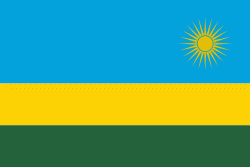Flag of Rwanda
The flag of Rwanda (ibendera ry'Urwanda, Drapeau du Rwanda) was adopted on 25 October 2001.
The flag has three colours: blue, yellow, and green, The light blue band represents happiness and peace, the yellow band symbolizes economic development, and the green band symbolizes the hope of prosperity. The yellow sun represents enlightenment.
The flag represents national unity, respect for work, heroism, and confidence in the future. According to the state's official rationale, the flag was adopted (along with a new national anthem at the time) to avoid connotations to the 1994 genocide which it stated the previous one embodied. However, some Rwandans at the time expressed doubts about the reasoning and viewed it as an attempt by the ruling Rwandan Patriotic Front to express its political power by changing state symbols. The flag was designed by Alphonse Kirimobenecyo.
When hung vertically, the flag should be displayed as the horizontal version rotated clockwise 90 degrees.
The flag has three colours: blue, yellow, and green, The light blue band represents happiness and peace, the yellow band symbolizes economic development, and the green band symbolizes the hope of prosperity. The yellow sun represents enlightenment.
The flag represents national unity, respect for work, heroism, and confidence in the future. According to the state's official rationale, the flag was adopted (along with a new national anthem at the time) to avoid connotations to the 1994 genocide which it stated the previous one embodied. However, some Rwandans at the time expressed doubts about the reasoning and viewed it as an attempt by the ruling Rwandan Patriotic Front to express its political power by changing state symbols. The flag was designed by Alphonse Kirimobenecyo.
When hung vertically, the flag should be displayed as the horizontal version rotated clockwise 90 degrees.
National flag
Country - Rwanda
Warning: getimagesize(/Image/Map/MP49518.gif): failed to open stream: No such file or directory in /home/mapnlee7/public_html/MAPNALL/article.php on line 532
 |
 |
Hunter-gatherers settled the territory in the Stone and Iron Ages, followed later by Bantu peoples. The population coalesced first into clans, and then, into kingdoms. In the 15th century, one kingdom, under King Gihanga, managed to incorporate several of its close neighbor territories establishing the Kingdom of Rwanda. The Kingdom of Rwanda dominated from the mid-eighteen century, with the Tutsi kings conquering others militarily, centralising power, and enacting anti-Hutu policies. In 1897, Germany colonized Rwanda as part of German East Africa, followed by Belgium, which took control in 1916 during World War I. Both European nations ruled through the Rwandan king and perpetuated a pro-Tutsi policy. The Hutu population revolted in 1959. They massacred numerous Tutsi and ultimately established an independent, Hutu-dominated republic in 1962 led by President Grégoire Kayibanda. A 1973 military coup overthrew Kayibanda and brought Juvénal Habyarimana to power, who retained the pro-Hutu policy. The Tutsi-led Rwandan Patriotic Front (RPF) launched a civil war in 1990. Habyarimana was assassinated in April 1994. Social tensions erupted in the Rwandan genocide that span of one hundred days. The RPF ended the genocide with a military victory in July 1994.
